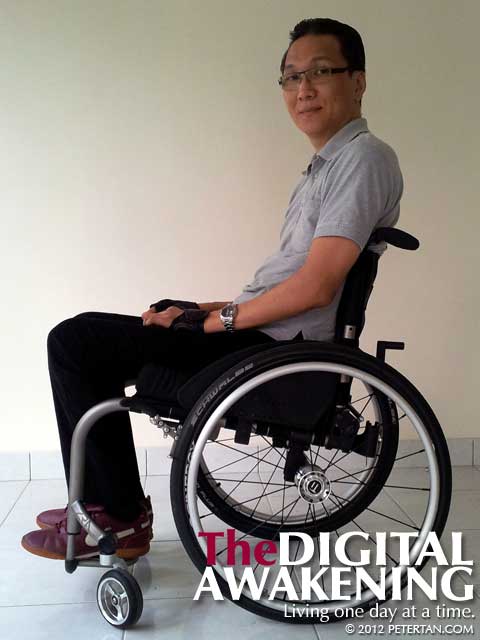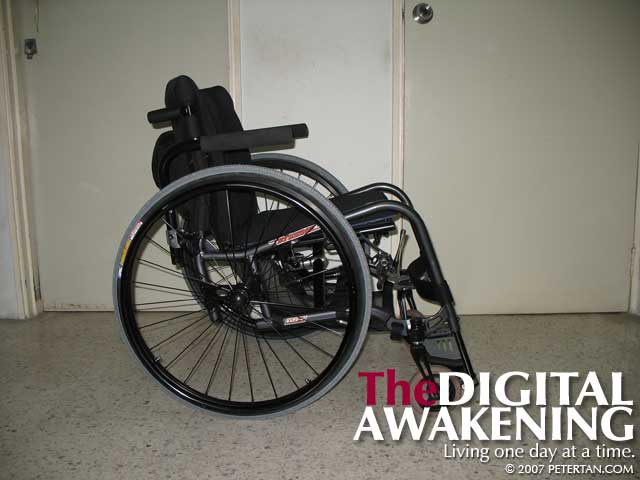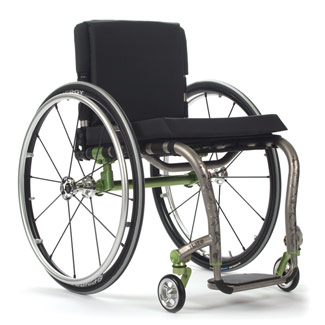My first wheelchair was an Everest & Jennings. At RM1,800, it cost as much as a Honda C70 motorcycle then. It was foldable with full reclining back, removable full support headrest, detachable armrests, and removable and elevating legrests. It was heavy like a tank and handled like one. My weak hands made it even more difficult to propel. I yearned for a smaller and lighter wheelchair.
Over the next two decades, I went through three standard folding wheelchairs with detachable armrest and footrests. In between that, I also had an Etac, a rigid frame wheelchair that was one size too small. I moved on to my first customised folding wheelchair in 2007. The Max Pleasure Synergy set me back more than RM5,000. Unfortunately, the axle broke just after three years.
Fed up with having to repair broken axles and other parts of wheelchair frames every now and then, I decided that I wanted a rigid wheelchair. With less moving parts, there are less probabilities of parts breaking down. Compared with folding wheelchairs, a rigid wheelchair has less flex of the frame. This translates to a more efficient push. I narrowed the search down to the Tilite ZRA Series 2 which is an ultralight rigid titanium wheelchair. As it would be custom-built, precise measurements were needed. It was also to be the most expensive I had ever paid for a wheelchair.
I did extensive research on getting the right measurements and accessories, mostly at the CareCure Community, a forum for people living with spinal cord injury. After an exhaustive two-month of reading up on the experience of people using similar wheelchairs, asking questions and getting good advice and suggestions, I felt that I was ready and placed my order with Bike-On, an online store dealing in wheelchairs and handcycles.

CAD of my Tilite ZRA Series 2 wheelchair.
The following are the final measurements for the wheelchair:
Rear seat width: 16″ (no taper)
Seat depth: 17″
Front seat height: 19″
Rear seat height: 15.5″
Cushion: Supracor Stimulite Sport
Front frame angle: 85 degrees
Seat to footrest: 15.5”
Footrest: Titanium with flat ABS cover, 4″ narrow than rear seat width (1.5″ taper)
Seat back type: Folding titanium adjustable height that locks when folded
Tishaft back release bars: Titanium
Integrated push handles
Seat back: Medium folding set at 16″ + 4″ deep rigidizer bar
Seat back angle: 95 degrees
Centre of gravity: 2″
Rear wheel spacing: 1″
Camber: 2 degrees (Titanium)
Front casters: 5″ x 1″ plastic wheels with poly tires
Front forks: Tilite standard
Rear wheel: 24″ Spinergy Spox (black)
Rear wheel tires: Schwalbe Marathon Plus Evolution
Axel: Stainless steel quick release
Handrims: Aluminium, long tab
Wheel locks: Uni Locks, pull to lock
Back upholstery: Black, tension adjustable by straps
Seat upholstery: Tension adjustable bolt-on
Side guards: Aluminium rigid removable
Armrests: Swing away flip-back tubular

Tilite ZRA Series 2 ultralight titanium Wheelchair.
I have used the Tilite ZRA Series 2 for slightly more than one year now. The measurements for the wheelchair were almost perfect and needed no adjustment when I took delivery of it. Credit must certainly go to the members of Care Cure Community Forum who gave valuable feedback and comments. Having said that, I also understand better now how the wheelchair can be further fine tuned for an even better fit.
My posture has improved termendously. My feet sit flat on the footrest although I now would prefer the footrest to be positioned further forward at 80 degrees instead of the current 85 degrees. Being tucked in like that is causing poor circulation and edema of the feet. Otherwise, the positioning of my legs and feet have reduced occurrences of spasms. (SCI_OTR has since advised that increasing the seat depth from 17″ to 18″ while maintaining the front angle at 85 degrees would give the same result of having my feet further forward as an 80 degree front agle.)
The folding backrest had some play to it when upright. The locking stud on the left kept coming loose and had to be tightened often. One of the pins in the folding mechanism also kept slipping out. This was a known fault of the ZRA Series 2. Tilite redesigned the mechanism to resolve the issues. I requested for a replacement through Bike-On. It was delivered via UPS several weeks later. A big thumbs up to Tilite and Bike-On for this painless process.
The first few months using the Tilite standard forks and plastic front casters gave me a bumpy and uncomfortable ride. I could even feel the bumps while rolling across the thin gaps of tiled floors. The ride became significantly smoother after the forks and casters were replaced with Frog Legs Uni Tines and aluminium Epic soft roll casters. Besides, hair that used to get wound round the axles were drastically reduced.
Other than the position of the footrest that I would like changed, I am also considering a rigid backrest, rigid seat pan and the Q-Grip handrims. The rigid backrest and seat pan could provide better support and at the same time further improve my posture. However, I need to add an extra inch to the seat depth to accommodate the rigid backrest which means I cannot install it on my current wheelchair. The Q-Grip handrims are coated with non-slip neoprene. This will allow me to push the wheelchair more efficiently which my weak hands cannot do with the current anodised handrims. I plan to have these upgrades for my next wheelchair.
All said, I have no regret whatsoever in forking out the amount I paid for the Tilite ZRA Series 2, it being the most important piece of equipment for my mobility and independence. In fact, I wished I had gotten one earlier. I have nothing but praises for the ZRA for its full adjustability, not that I have had the need to adjust anything. The best thing about this wheelchair is that I look good in it. This is my best wheelchair yet and the rigid frame is the only way for me now.


